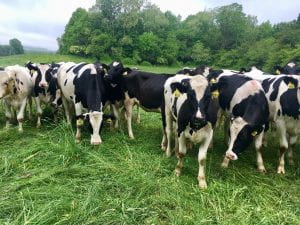June 14, 2022 – Grazing dairy heifers on pasture can reduce the cost of production and, for bred heifers, improve health at calving. Allowing the heifer to harvest its own forage and spread its own manure reduces machinery, fuel, and labor costs.[i] Grazing prior to calving reduces the incidence of post-partum disorders in bred heifers.[ii] Like any other management regime, grazing takes high quality management to be successful, and it does not fit every manager’s style. Grazing adds complexity to dairy production systems, as there are many more variables to manage on pasture than in confinement. Dairy managers interested in grazing heifers must decide whether to create and manage their own grazing system or work with a custom grazier.
Considerations for developing a successful heifer grazing enterprise will be part of the Custom Grazing Pasture Walk from 12:30-2:30pm on July 6, 2022 at Maridale Farm, 545 Turnpike Rd, Cayuga, NY. The event is hosted by CCE Cayuga and the CCE South Central NY Dairy and Field Crops Regional Team, and is part of a Summer 2022 South Central NY Graziers Pasture Walk Series. A second pasture walk featuring rotational grazing of beef cattle and a soil health workshop will take place from 6:30-8:30pm on July 6, 2022 at Will-Sho Farm, 1913 Dixon Rd, King Ferry, NY. For more information about these two events, contact CCE Cayuga Ag Program Educator Ron Kuck by phone at (315) 255-1183 or email at rak76@cornell.edu.
Economic Benefits
Research from Minnesota and New York has shown that grazing yearlings and bred heifers can reduce the overall cost to raise replacement heifers. In my own research, I compared costs of grazing heifers on two New York dairies to data published by Cornell PRO-DAIRY documenting the cost of raising heifers in confinement. [iii] Just the feed and labor costs of raising heifers in confinement exceeded the cost of working with a custom grazier, before accounting for additional savings on fuel, machinery, and repairs.
Health Benefits

In the New York study, I used pedometers to measure the number of steps taken by heifers on pasture and in confinement. The grazing animals took roughly 6,000 steps per day, while the animals in confinement took 2,000 steps per day. This extra exercise translated to increased feed intake for the heifers on pasture. In the Minnesota study, grazing animals ate 24 pounds of dry matter per day, on average, compared to 19 pounds of dry matter per day consumed by animals in confinement. The higher dry matter intake in the grazing group continued up to and beyond calving. This elevated dry matter intake helped to reduce the energy imbalance that can happen at calving, causing various post-partum issues. As a result, the grazing group had a lower incidence of post-partum disorders. The additional exercise helped grazing heifers transition through calving and meet the metabolic demands of milk production.
How To Start Custom Grazing
If a dairy is looking to adopt grazing as part of their management system, they need to decide whether they have the resources to add it to their operation, or whether to send heifers off site to a custom grazing operation. As stated earlier, grazing management is not for every producer. Managing pasture to always be at the most nutritious stage of growth, and avoiding various grazing pitfalls, takes experience. Dairy producers interested in learning more about grazing heifers should consider attending our pasture walk and custom grazing workshop at Maridale Farm on July 6. If you cannot attend the pasture walk, visit the NE SARE website to access a series of fact sheets on grazing dairy heifers.[iv] More information and resources on grazing in your region may be available at your local CCE county office or the county Soil and Water Conservation District.

